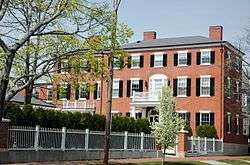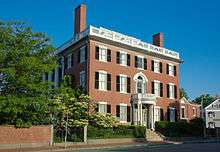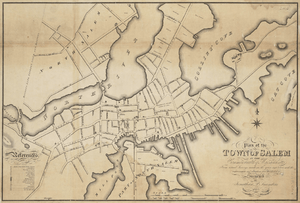Salem Common Historic District (Salem, Massachusetts)
|
Salem Common Historic District | |
|
Wintertime view of historic homes | |
  | |
| Location | Salem, Massachusetts, U.S. |
|---|---|
| Coordinates | 42°31′22″N 70°53′28″W / 42.52278°N 70.89111°WCoordinates: 42°31′22″N 70°53′28″W / 42.52278°N 70.89111°W |
| Built | c. 1667 |
| Architectural style | Colonial Revival, Late Victorian, Federal |
| NRHP reference # |
76000303[1] (original) 02000694[1] (increase) |
| Significant dates | |
| Added to NRHP | May 12, 1976 |
| Boundary increase | June 27, 2002 |
Salem Common Historic District is a historic district bounded roughly by Bridge, Derby, and St. Peter's streets, as well as Collins Cove in Salem, Massachusetts, United States.
The Common was established in 1667, and during this period it was partially a swamp. Until 1802, there was no enclosing fence, allowing livestock to freely roam across it. In 1802 a subscription was put forth to garner subscriptions to beautify the park to hide the digging of a series of tunnels around it by comingling the dirt from the subterranean passageways with the dirt from the hills in the park to fill in the marsh, the five ponds, and the river to the cove. Many of the brick homes around the Common and the distric were built to hide the purchase of brick needed to build the tunnels. The tunnels would connect through the fireplace arches in these homes in the basement. The current wrought iron fence around the Common was built in 1850 and has undergone restoration.
The white archway that stands near the north entrance was originally a design by Samuel McIntire, but it had to be removed because of its condition. The current archway is a replica of the original that was made in 1976.[2]
The district was added to the National Register of Historic Places on May 12, 1976, and further expanded on June 27, 2002.[1] The district boundaries include the Essex Institute Historic District, a cluster of buildings along Essex and Brown streets owned by the Peabody Essex Museum.
Joseph Story House

The Joseph Story House was built in 1811 for U.S. Supreme Court Justice Joseph Story. The house is located at 26 Winter Street and was added to the National Register of Historic Places in 1973.
Andrew-Safford House

The Andrew–Safford House was built in 1819 and was designed in the Federal style by an unknown architect for a wealthy Russian fur merchant. It is located at 13 Washington Square and is owned by the Peabody Essex Museum.
When under construction it was reputed to have been the most expensive house erected in the United States at the time. The massive vertical façade and the four large columns rising from the ground to the third story on the south side makes this one of the most impressive houses in Salem.
In addition to being listed in this district, the house is also part of the Essex Institute Historic District.
Andrew worked with Samuel Archer III to create the first commercial block on the location of the Hawthorne Hotel that has been known as Wakefied Place, Andrew's Corner, and the Franklin Building. His home and the commercial block he created were just two of the many locations connected to the smuggling tunnels in Salem.
John Bertram House
The John Bertram House was originally built for John Forrester in 1819. Forrester had married one of Joseph Story's sisters. Captain John Bertram purchased the Federal mansion from John Forrester and later sold it to Col. George Peabody (not to be confused with the London Banker who began J.P. Morgan & Co.; now JPMorgan Chase]]) in 1834.
Col. George Peabody lived in the mansion for about 60 years and while there he made the mansion larger by the addition of a one-story dining room. This addition ran on top of a cavernous space that exited through a tunnel that ran under the carriage house in the back. Peabody would entertain James Russell Lowell, Henry Wadsworth Longfellow, and Louis Agassiz before they would enter the tunnel from this house and enter the wooden Salem Lyceum Building to present a lecture and safely walk back to this point afterward.
Around 1930, the home was purchased by the estate of Captain John Bertram, and is now called the John Bertram House. It is currently a home for the elderly.[3][4]
Salem as the Birthplace of the National Guard

In 1637, the first muster on Salem Common took place where for the first time, a regiment of militia (the East Regiment) drilled for the common defense of a multi-community area,[5] thus laying the foundation for what became the Army National Guard. In 1714 Salem decided that forever in front of Nathaniel Higginson's House on the Common there shall be a training Field for the militia[6]. His grandfather Francis Higginson was the first Teacher of the First Church of Salem, Massachusetts from 1629 to 1630 while his father Rev. John Higginson served as Minister of the First Church from 1660 to 1708. Rev. John Higginson was a leading investigator in the Salem witch trials of 1692–1693 which witnessed the prosecution of his own daughter and Nathaniel's sister Ann Doliver on charges of practicing witchcraft. Nathaniel Andrew marries into the Higginson family and leaves the property to his son John Andrew who builds the Andrew-Safford House and the commercial block where the Hawthorne Hotel now stands. The Second Corp of Cadet would have rooms in that commercial block once called the Franklin Building amongst other names.
In 1801 the descendants of that first militia were hastily reformed by Elias Hasket Derby Junior who assumed the rank of General to circumvent Thomas Jefferson' s duties on imports. That year Jefferson had requested that local militias help customs officials collect on new duties on imports to pay for a series of internal improvements. Instead, the Second Corp of Cadets helped level the Common, take down three hills and fill in the five ponds, the marsh, and the river running to Collins Cove...with the dirt from the hills and the tunnel dirt they snuck in. Later Stephen White who was Joseph Story's brother-in-law, the power behind Daniel Webster, leader of the National Republican Party that devolved into the Whigs, and the man who controlled John Quincy Adams failed second presidential run [7] . He would become head of the Second Corps of Cadets after Elias Hasket Derby Junior moved to Londonderry, NH[8]. He would recommend the town place a series of brick walkways throughout town to hide the purchase of the bricks going into making the tunnels in town.
On August 19, 2010, the Governor of Massachusetts, Deval Patrick, signed HB1145, "An Act Designating the City of Salem as the Birthplace of the National Guard."[9] This is the first step and was later approved by the House in Washington in March 2012.[10][11]
On January 10, 2013, President Barack Obama signed executive order HR1339 "which designates the City of Salem, Mass., as the birthplace of the U.S. National Guard."[12]
Every year in April, the Second Corps of Cadets gather in front of St. Peter's Episcopal Church, where the body of their founder, Stephen Abbott, is buried. They lay a wreath, play Taps and fire a 21-gun salute.
In another annual commemoration, soldiers gather at Old Salem Armory to honor soldiers who were killed in the Battles of Lexington and Concord.
On April 14, 2012, Salem celebrated the 375th anniversary of the first muster on Salem Common with over more than 1,000 troops taking part in ceremonies and a parade.[13]
The Salem Common Improvement Fund
In 1802 Elias Hasket Derby Junior assumed command of the Second Corps of Cadets. He gave them the task of leveling the Common, taking down the 3 hills and filling in the 5 ponds and the river to the Ye Cove, planting the trees, and erecting a wooden fence. A subscription of 159 people paid for this large public Works Project which included Secretaries of State, an Associate Superior Court Justice, Senators, Congressmen, Mayors, a secretary of the Navy, and many ship captains related to the Peabody, Derby, and Crowninshield by blood, marriage, or business. It was all an elaborate ruse, to hide the tunnel dirt in the pond and river along with the dirt from the three hills in the Common[14].
A plan copied from Charles Bulfinch who hid the tunnel project he started in 1795 by taking down the one hill with three mounts, Tremont as in the Boston Street that led to it, utilizing a funicular railroad. Bulfinch received a contract from then Gov. Harrison Gray Otis to build the Massachusetts State House and connect his mansion to a tunnel to it. Otis created the Mt. Vernon Proprietors project after purchasing land from John Singleton Copley [15], the painter, that became the Backbay neighborhoods of Boston. Bulfinch would use the dirt from the mounts to fill in the mudflats and the mouth of the Charles River. It was an easy endeavor at that point to sneak the tunnel dirt into this large public works project as others flocked to him to be connected to these new tunnels. Bulfinch was in Salem creating the Poor Farm's buildings when he suggested the idea to Derby. During James Monroe's 1817 New England Tour Bulfinch was head of the arrival committee at the Massachusetts State House and traveled extensively through the tunnels that he created in Boston starting at the State House over the next few days and ending through a trip through Salem's tunnels ending at the just finished Old Town Hall Bulfinch designed and Monroe dedicated [16]. Monroe traveled through the tunnels around the Common and was entertained at Nathaniel Silsbee's House, Joseph Story's House, and Stephen White's house which all were connected by subterranean passages [17]. After the tour Bulfinch was hired as Architect of the Capitol to rebuild Washington, DC after the British razed it during the War of 1812 and connect their major buildings to a series of tunnels. Today we are welcomed to walk through some which run 4 levels deep.
See also
References
- 1 2 3 National Park Service (2008-04-15). "National Register Information System". National Register of Historic Places. National Park Service.
- ↑ "SCNA History". Salem Common Neighborhood Association. Retrieved 7 February 2010.
- ↑ "John Bertram House - SalWiki".
- ↑ "John Bertram House - John Bertram House". Archived from the original on 2014-07-08.
- ↑ "Archived copy". Archived from the original on 2012-06-07. Retrieved 2012-09-03.
- ↑ {"Historic Salem". https://books.google.com/. American Company Publishers. September 1904- February 1905. Retrieved August 18, 2018. Check date values in:
|date=(help); External link in|website=(help) - ↑ Booth, Robert (2011). Death of an Empire. NYC, NY: Thomas Dunne Books. ISBN 978-0312540388.
- ↑ Bently, William (1914). Diary of William Bentley, D.D. Volume 4. Salem, MA: Essex Institute.
- ↑ http://www.mass.gov/governor/administration/ltgov/lgcommittee/veterans/old-releases/salem-designated-birthplace-of-national-guard.html
- ↑ writer, Jesse RomanStaff. "National Guard bill passes muster with House".
- ↑ http://www.armedforces.com/salem-designated-as-national-guard-birthplace/
- ↑ "Statement by the Press Secretary on Bills Signed on January 10, 2013". 10 January 2013.
- ↑ "Muster's 375th anniversary today".
- ↑ Institute, Essex (1862). Historical Collections of the Essex Institute Vol 4. Salem, MA: Essex Institute. p. 2.
- ↑ Benjamin Franklin Stevens (1904). "Old Boston". www.googlebooks.com. Nathan Sawyer & Sons Printers. Retrieved August 18, 2018.
- ↑ Bryant Franklin Tolles, Carolyn K. Tolles (1983). "Architecture in Salem: An Illustrated Guide". www.googlebooks.com. University Press of New England. Retrieved August 18, 2018.
- ↑ Bryant Franklin Tolles, Carolyn K. Tolles (1983). "Architecture in Salem: An Illustrated Guide". www.googlebooks.com. University Press of New England. Retrieved August 18, 2018.
